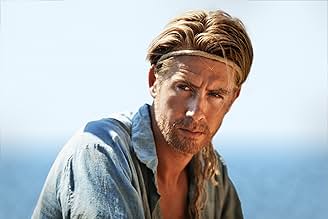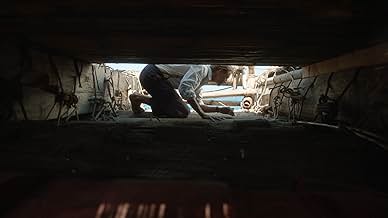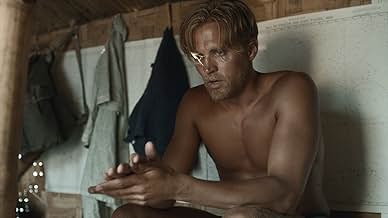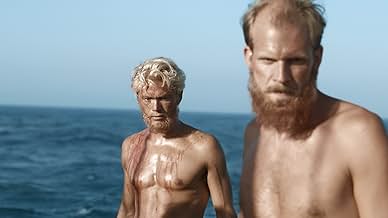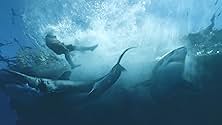Nel 1947, l'esploratore leggendario Thor Heyerdal ha attraversato il Pacifico per sette mila chilometri su una zattera, nel tentativo di dimostrare che era possibile che i sudamericani si st... Leggi tuttoNel 1947, l'esploratore leggendario Thor Heyerdal ha attraversato il Pacifico per sette mila chilometri su una zattera, nel tentativo di dimostrare che era possibile che i sudamericani si stabilissero in Polinesia in epoca precolombiana.Nel 1947, l'esploratore leggendario Thor Heyerdal ha attraversato il Pacifico per sette mila chilometri su una zattera, nel tentativo di dimostrare che era possibile che i sudamericani si stabilissero in Polinesia in epoca precolombiana.
- Regia
- Sceneggiatura
- Star
- Candidato a 1 Oscar
- 12 vittorie e 14 candidature totali
- Thor Heyerdahl
- (as Pål Hagen)
- Herman Watzinger
- (as Anders Baasmo Christiansen)
- Thor 6 yrs.
- (as Kasper Ameberg Johnsen)
Recensioni in evidenza
Beautiful cinematography...including magnificent scenes of whales & sharks circling the raft.
Character studies of Thor Heyerdahl & his companions on the journey are intelligent subtle portrayals. Thor is one driven man, from almost drowning in childhood to landing on the beach on Roraia, Indonesia. Thor spent ten years with his theory that Polynesia was settled from Peru; not from Asia, the settled hypothesis at the time. Final proof came via the 1947 voyage on a raft using the same 1500 year old techniques of navigation and raft construction. While this may sound a bit dry, it is not. The passion of the participants is palpable. Each has their own reason for going on the journey; most simply falling under Heyerdahl's charisma. (Heyerdahl's 1950 documentary won the Academy Award, and remains the only Norwegian winner of an Academy Award to date.)
Though not cast based simply on physical looks (per the co-directors), several are magnificent specimens of blond 1940s fit men...and their bonding.
Every scene was filmed first in Norwegian, then in English; (US release of the English version seen is expected by the Weinstein group later in 2013.) Filming was 59 days in six countries. Audience reaction of the PSIFF screening was loudly appreciated followed with Q&A with the co-directors.
NB: now willing to watch the original Kon-Tiki documentary film, that won Oscar in 1950, directed by Thor Heyerdahl himself during their expedition___:))))
Anyway, even though I have not watched nor have any knowledge of the original, I am impressed with the way this film was made. It was pretty well-balanced with no major flaws in my opinion. Well acting performances by the cast were complemented by a high level of cinematography technique that made looked like the entire journey on the raft was really shot wide in the ocean. Like Life of Pi, there were certain marine animals that were infamously being shown from the real life account of Kon-Tiki, and the CGI made on the animals were so real you probably cant tell if those animals were fake.
Probably the major point of improvement that the film can work on is the lack of character development of the other participants in the Kon Tiki, aside from Thor Heyerdahl himself. I am not implying there was none, as we get to see Thor's mates conflicts happening from the start till the end, but I wish I could have known more why they decided to join and their background story. Understandably, with the time given the film had chosen to focus on Thor instead with a lot of plot material explaining why he had to venture into such a journey.
I was also curious if there were more that could be shown about a group of men enduring a raft journey across the ocean in +100 days. But overall, just by solely comparing the similarities, this is much better and believable than Life of Pi as well as a very satisfying movie experience.
*** (out of 4)
Visually stunning telling of explorer Thor Heyerdahl's (Pal Sverre Hagen) epic and now legendary journey traveling nearly 5,000 miles from Peru to Polynesia in a wooden raft. Directors Joachim Ronning and Espen Sandberg certainly do a marvelous job in bringing this story to the screen, although I think the screenplay at times could have given more information than what we're just seeing. I think a little more character development might have helped the film somewhat but there's still no question that this here is mighty impressive and especially considering the budget. I think the best thing in the film is the wonderful visuals and right from the start they just leap right off the screen. Whether it's the snowy landscape of Norway or the beautiful blues of the sea, the look of this movie is something that makes you just want to pause the film and admire its beauty. The cinematography is top-notch and I'd argue some of the best that I've seen in recent years. The cinematography certainly helps grab all of these beautiful images but I also think it's so good that it also takes the viewer and places them directly on the boat to experience everything that happens. As for the real story, seeing it unfold here makes for a thrilling adventure that deals with some bickering between the men but also some breathtaking moments involving a whale and some highly intense scenes with sharks. The acting is another major plus as all the key people do a wonderful job in the film even while none of their characters really jump out at you except for the lead. The film is certainly very uplifting and inspirational and it really makes you respect these explorers for everything they did and of course their bravery. This film is certainly a fitting tribute to the men who went on this mission.
During the 20th century some individual achievements so captured the popular attention as to become iconic: Lindberg's flight across the Atlantic, Hillary and Norgay's conquest of Everest, Roger Bannister's four minute mile. Thor Heyerdahl's 1947 voyage across the Pacific was one of these events. His book, Kon-Tiki, sold tens of millions of copies, and his 1950 documentary won an Academy Award, as much a recognition of the feat as the film.
Norwegian directors Joachim Rønning and Espen Sandberg have now decided to put on the screen a dramatized account of Heyerdahl's expedition. But the obvious question is how can you make interesting the story of six men confined to a small wooden raft for 101 days? In fact by comparison to the exploit it recorded, the original documentary came across as rather bland, precisely because of such limitations. But this new film is anything but tame, and succeeds in combining striking photography of the adventure itself with a compelling look at one man's quest to show that "it can be done."
The strength of the picture is that it situates the voyage within the context of Heyerdahl's struggle to get the scientific and financial support to try out his theories. He had speculated that Polynesia was settled by Inca voyagers who had used the prevailing currents to drift across the Pacific on rafts similar to the one he would build. (He proved this possible, although DNA testing suggests that Polynesians share a predominantly Asian heritage.)
Heyerdahl had developed this premise much earlier, but after World War II, he made serious attempts to secure the backing for a voyage that would test his theories. Not only did he encounter opposition from those who felt that he was wrong, but even more often he was dismissed as a fanatic with a suicidal plan.
Eventually he did manage to scrounge some backing, including private loans, help from the Peruvian authorities and supplies from the U.S. Navy. Perhaps more importantly, he found five companions who had confidence enough to put their lives in his hands. All were Norwegian except Bengt Danielsson, a Swede with an interest in migration. Erik Hesselberg was the navigator. Knut Haugland and Torstein Raaby, both heroes of the Norwegian resistance, were the radio experts. Herman Watzinger was an engineer who helped design the raft, and who recorded much of the voyage's scientific data.
Although he took along modern equipment, Heyerdahl was concerned that the raft itself should be constructed only from materials that were available in ancient times. Accordingly the raft was constructed from logs tied together with rope, surmounted by a thatched cabin and a large cloth sail. The raft itself was about 45 by 18 feet (13.7 by 5.5 m), and the cabin about 14 by 8 (4.2 by 2.4 m). The crew sailed from Callao, Peru, on April 28, 1947 and arrived in Raroia in the Tuamotu Islands on August 7.
The film succeeds by contextualizing these 101 days at sea against Heyerdahl's struggles to get the expedition underway. Although the inevitable storm and the equally foreseeable shark attack have their moments, the movie similarly attends to the relationships among the expedition's six members, their level of bonding to Heyerdahl as leader, and his own relationship with a wife who wanted to be supportive, but who found the risks unacceptable. It establishes the overall context by its early sequence dealing with Thor's honeymoon stay in the Marquesas, where he began to discover the apparent Inca connections that led to his theories.
In the central role of Thor Heyerdahl, Pål Sverre Valheim Hagen must carry the story, and he does. His re-creation of the historical character is convincing as the embodiment of determination, not quite obsessive but coming close, as he plans, argues and cajoles to try to turn his project into a reality. As his fellow Norwegian crew members Odd Magnus Williamson as Hesselberg, Tobias Santlemann as Haugland, and Jacob Oftebro as Raaby are equally credible figures: young, heroic, and willing to give Heyerdahl their trust. Playing the only non-Norwegian in the group, Gustaf Skarsgård as Bengt Danielsson is a little detached, but perhaps even more intellectually committed than the others to what they are about. For contrast and drama, the filmmakers apparently took liberties with the character of Herman Watzinger, played by Anders Baasmo Christensen. Christensen does well with the part given him, although the real-life Watzinger was almost certainly stronger and more competent than the movie shows him. Given that she must play an ambivalent role, Agnes Kittelsen as Liv gives a very effective performance as Thor's wife and the film's only prominent female character.
Gorgeous photography and great production values set Kon-Tiki off. The Pacific Ocean scenes were actually shot in the waters off Malta, the tropical ones in the Maldives and Thailand, with other locations in Norway and the U.S. used as appropriate. It is a real accomplishment that even with the limited space of the raft cinematographer Geir Hartly Andreassen never lets it become visually boring. Going from the micro to the macro, he manages to keep interesting also the vast empty spaces of the ocean, which emerges as a living character in its own right, often peaceful, sometimes petrifying, always powerful.
It must have been a temptation for the directors and principal screenwriter Petter Skavlan to fictionalize Heyerdahl's exploits and to create a stunning action/adventure tale on the lines of A Perfect Storm or White Squall. Thankfully they recognized that Heyerdahl himself was a character larger than life whose daring voyage became an extension of himself and his ambitions. In doing that they keep alive the iconic figure that he was, and give audiences some appreciation of how the sheer willpower of one individual can produce deeds that capture the imagination of the world.
Lo sapevi?
- QuizLarge parts of the film were filmed in two versions at the same time, one in Norwegian, the other in English, in order to secure international funding. See ALTERNATE VERSIONS section for greater detail.
- BlooperThe crew were not worried about whether the ropes would hold the float together, as it is portrayed in the film. As we can see in the Kon-Tiki (1950) documentary, the balsa wood was much softer than the rope, and it was actually the rope that ate through the wood. The result was that the rope eventually was protected by the space that had been created around it.
- Citazioni
Epilogue: Bengt fell in love with Polynesia. He settled there and became a Consul General of Sweden. He died in 1997.
Epilogue: Erik built himself a sailboat, that became his home for 11 years. He worked as an artist until his death in 1972.
Epilogue: Torstein kept going on expeditions. He died in 1964 during an attempt to reach the North Pole on skis.
Epilogue: Knut resumed his career in military intelligence. He was also instrumental in the establishment of the Kon-Tiki museum. He died the Christmas of 2009.
Epilogue: Herman became the director of UN's Food and Agriculture organization. He died at Titica lake in 1986.
Epilogue: Thor wrote a book about Kon-Tiki. It was translated to over 70 languages, and sold over 50 million copies. The documentary about the expedition won an Oscar. Liv and Thor divorced after the Kon-Tiki expedition. Their boys lived with Liv, who later moved to the US where she died in 1969. Thor continued his work as an experimental archaeologist, author and explorer. He died in 2002.
- Curiosità sui creditiBefore the closing credits, short clips are shown in which original footage shot by Heyerdahl was reenacted by the "Kon-Tiki" actors: urinating overboard in the open sea, dancing with natives under palms, portraits, and the like. Along with this, brief notes concerning each crew member's path of life after the trip are given.
- Versioni alternativeIn an unusual technique, the film was shot simultaneously in both Norwegian and English, with each scene being filmed twice, first in Norwegian and then in English, with the same actors. This resulted in two versions of the film to be released, one primarily for the Norwegian domestic market, the other for an international audience. In a few cases, such as action scenes and computer-generated sequences, they used the same shot, later adding English with dubbing.
- ConnessioniFeatured in 70th Golden Globe Awards (2013)
- Colonne sonoreFlickan i Havanna
("The girl in Havana")
Lyrics by Evert Taube (as Taube) and music by Horatio R. Palmer (as Palmer)
I più visti
Dettagli
- Data di uscita
- Paesi di origine
- Siti ufficiali
- Lingue
- Celebre anche come
- Un viaje fantástico
- Luoghi delle riprese
- Nu Boyana Film Studios, Sofia, Bulgaria(New York exterior scenes)
- Aziende produttrici
- Vedi altri crediti dell’azienda su IMDbPro
Botteghino
- Budget
- 16.600.000 USD (previsto)
- Lordo Stati Uniti e Canada
- 1.517.410 USD
- Fine settimana di apertura Stati Uniti e Canada
- 22.168 USD
- 28 apr 2013
- Lordo in tutto il mondo
- 22.842.887 USD
- Tempo di esecuzione1 ora 58 minuti
- Colore
- Mix di suoni
- Proporzioni
- 2.35 : 1
Contribuisci a questa pagina






